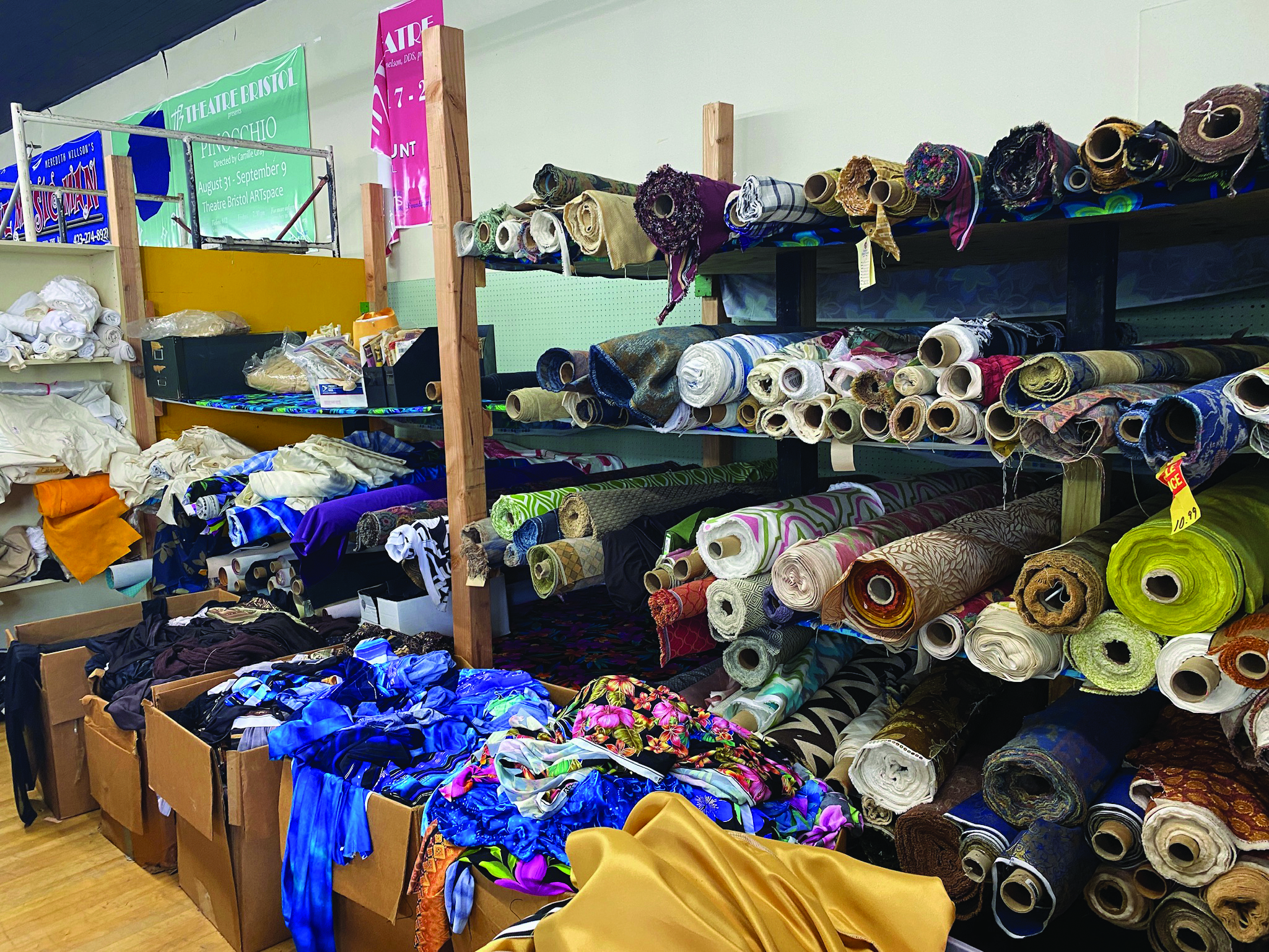

Costume Shop
From Triton’s staff and Anne Frank’s diary to “Steel Magnolias’” beauty shop and “Chitty Chitty Bang Bang’s” backfire, there is always something being made at Theatre Bristol by creative volunteers.
Theatre Bristol is a type of “maker space,” a theater maker space, that welcomes and depends on local talent to share their passions and creativity.
Maker spaces are collaborative locations that promote creating. Theater maker spaces act as a hub for community engagement that offers creativity and innovation. Theater maker spaces contribute to the sustainability of the theater community, the development of skills and the sharing of innovations. Maker spaces provide access to equipment, materials, stagecraft tools, costume design supplies, lighting equipment etc., that might not be accessible to individual artists.
Theater maker spaces are places of shared learning and make hands-on learning available to the public. The space provides opportunities for developing new theatrical works, nurturing emerging artists and exploring innovative performance practices. Makers leverage their curiosity, their gifts and talents, their expertise and create together. Typically, maker spaces are open spaces used for tackling DIY projects, creative problem solving and learning new technologies. Theatre Bristol’s maker spaces invite the same creativity and opportunity in the context of a production.
Unless you’ve visited Theatre Bristol, you may not realize the thousands of square feet of workshops within the space.
To start, just beyond the ARTspace stage, the former Ball Brothers furniture store opens up into the Scene Shop full of construction space, tools arranged along walls, battery charging stations and every variety of saw. Next to the Wood Shop, racks of wood of all sizes are stored not far from built flats or walls for repurposing from previous productions. Luke Gray coordinates the shop organization, and many volunteers help keep it all operational.
Many tools used daily classify as vintage while others are brand new like the Permatile Concrete Products sponsored “Saw Stop” that keeps the finger count at 10. Seasoned volunteer carpenters work alongside people stepping into the shop for the first time. On workdays over several weeks, they build tables or rooms, or pieces that only come from imagination to meet the needs of the script. They built skills while they build sets.
Painters and scenic artists select and mix donated paint in the adjacent Scene Shop. Lined with cans by color, paint finds a new destiny under stage lights. Artists and those holding a brush for the first time work side by side. Theatre Bristol is fortunate to have many talented artists lend a hand for a project or two, teaching as well as completing a special project from a show plan. Bert White designed original artwork for “Alexander and the Terrible, Horrible, No Good Very Bad Day” and “Pinocchio.” Rebekah McGrady designed all the artwork for “Elf! The Musical” on computer for volunteers like Catherine Lamie to transfer to set pieces.
“The Mockingbird Sings’” original digital projections made the 1927 recording sessions come alive on stage with Grace Walker’s talent. Artist Deanna Vanders painted larger than life-sized portraits of the baron and baroness for “Chitty.” Backdrops are both hand-painted as well as designed in-house and printed in large format.
In the tech booth, all the resources for audio, lights and special effects are ready to create music, moods and amazement. Albert Tester and volunteers made Lumiere’s “hands” glow, a car backfire, built Maurice’s woodchopper, and now prepare a collection of items for Charlie and the Chocolate Factory. Creative volunteers have learned rigging from Ken Cornett and D2 Flying to help Glenda, monkeys, outhouses and Chitty Chitty Bang Bang fly over the years.
Upstairs, you never know what you’ll find in the Prop Shop. It’s full of those just-in-case saved things — pieces of matching foam from shipping packages, beads, tubes, string, straw and most importantly, hot glue. The cabinets and tables are set up for arranging flowers or hot-glueing dinner rolls to platters. Award-winning creative, Rebecca Ryan, has crafted many period pieces that use modern 3-D printing technology to give accessible accuracy to stage productions. In addition, the shop is the workspace for electronics projects, many made with recycled materials.
At least 50 feet of storefront on the second floor is dedicated to rows of tables with sewing machines, dyeing and grommeting supplies, mannequins, racks of fabric bolts, remnants and notions. Lined with wigs in front of cages of backdrops, volunteers work at center tables in the room for cutting and arranging fabric. In wardrobe, thousands of square feet of costumes and accessories organized by type fill the third floor, along with props and set pieces. On display are three-piece costumes for “Little Women” and mermaid costumes for “The Little Mermaid.” designed and created by Camille Gray.
Being a part of this theater maker space is as simple as willingness to get involved, reaching out and expressing interest.
Selected pieces from these shops are on display for visitors to Theatre Bristol, including a horse from “Into the Woods,” Rabbit’s house from “Winnie The Pooh,” Professor Marvel’s wagon side, and “Joseph and the Amazing Technicolor Dreamcoat’s” coat and so much more.